AJET Connect Magazine Interviews an Award-winning Saga JET Author
 Via the Saga JET Programme website:
Via the Saga JET Programme website:
This month’s edition of AJET’s Connect Magazine features a double (DOUBLE) page spread interviewing current Karatsu City JET Andre Swartley about his award-winning book – Leon Martin and the Fantasy Girl. If you haven’t read this month’s edition, the interview and short review is below. If you want you buy a copy of the book click here.
Review and Interview: Leon Martin and the Fantasy Girl
Leon Martin and the Fantasy Girl delves into cultural exchange on a level that most people never get a chance to experience. When a group of American high school students arrive at a small German town for a summer work-study program, they find themselves caring for a potentially illegal alien in a life-threatening situation.
Leon and Autumn, a pair of teens staying with the same host family, are at the forefront of the action. Instead of spending their summer doing the work they traveled to Germany to do, they find themselves looking after a girl named Shin. Her presence is the glue that holds this story together, as well as what makes it so unbelievable. Shin’s story is vague at first and takes its time in clearing itself up.
The build-up to the second half requires readers to have some faith that that these characters will eventually find themselves in slightly more realistic situations, which they do. Spending a summer abroad in Germany is adventurous, but saving a fellow foreigner who should have been taken into custody from the beginning is a bit of a stretch. Read More
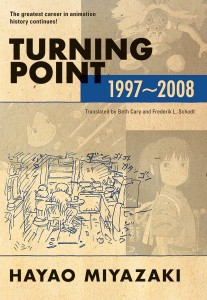
“With wit and humor, Miyazaki offers insight from his long career with every turn of the page. Like an unforgettable sunset or the first time a cooking experiment came out well, he discusses experiences that leave you unexpectedly changed.” (VIZ Media)
By Alexis Agliano Sanborn (Shimane-ken, 2009-11) for JQ magazine. Alexis is a graduate of Harvard University’s Regional Studies—East Asia (RSEA) program, and currently works as an executive assistant at Asia Society in New York City.
I consider myself an aficionado of director and animator Hayao Miyazaki and Studio Ghibli. Having seen his work countless times, visited the museum in Tokyo and done a fair amount of supplemental reading, I figured Turning Point—a collection of Miyazaki interviews and articles spanning 1997 through 2008 and newly translated by Beth Cary and Frederik L. Schodt—would probably be a rehash of the similar. I presumed it would be a book for Japan or anime specialists. On the back cover there’s even a quote from the L.A. Times: “Essential reading for anyone interested in Japanese or Western animation.” However, this statement is entirely too narrow and ultimately misleading.
In fact, the book (which is a sequel to Starting Point: 1979-1996, also translated by Cary and Schodt and now available in paperback) is less about animation and Japan than it is the human condition and those existential questions that keep you awake at night. Miyazaki, at one moment reserved and the other candid, plunges fearlessly into complex, introspective and intellectual issues about human’s relationship with education, child-rearing, philosophy, history, art, environmentalism and war (to name a few).
He does this with a sprinkle of romanticism and a dusting with realism. Using his seemingly continual dissatisfaction with the world, Miyazaki aims to positively spark change and inspire. He insists that his films are not just flights of fancy; rather, he makes them to motivate the next generation to improve the world. “Children learn by experiencing…it is impossible to grow up without being hurt,” he writes. “Experiences like: accepting the duality of human nature, the importance of grit, conviction, and perseverance, and respecting nature and the land….For children willing to start, our films become powerful encouragement.”
Justin’s Japan: Nippon in New York — Asa Akira, ‘Monkey Business,’ Jero @ Japan Day, Peelander-Z
By JQ magazine editor Justin Tedaldi (CIR Kobe-shi, 2001-02) for Examiner.com. Visit his Japanese culture page here for related stories.
As spring continues and the weather continues to warm, New Yorkers can enjoy activities all over the city both indoors and out.
May 2-3, 7:30 p.m.
Veggetti, Kato and Nakamura Project IX – Pleiades
Japan Society, 333 East 47th Street
$30, $24 Japan Society members
Two Japanese tour de force artists, acclaimed musician Kuniko Kato, praised by Steve Reich as a “first rate percussionist,” and dancer Megumi Nakamura, internationally known since her days with Jiří Kylián’s Netherlands Dance Theater, explore the mesmerizing scores of legendary 20th century composer Iannis Xenakis (1922-2001). Project IX – Pleiades, which features one of Xenakis’ most complex and ambitious pieces, Pléiades, is a multimedia work delivered through live performance and a state-of-the-art sound/projection installation. Directed by Italian choreographer Luca Veggetti, one of the featured artists in the 2014 NY PHIL BIENNIAL. The Friday, May 2 performance is followed by a MetLife Meet the Artists Reception.
Saturday, May 3, 2:00 p.m.
Monkey Business: Japan/America Writers’ Dialogue
Asia Society, 725 Park Avenue
$15, $12 seniors/students, $10 Asia Society and PEN members
In conjunction with PEN World Voice Festival 2014! For the past three years PEN World Voices and Asia Society have provided a place for dialogues between established and upcoming writers in the United States and Japan. This year Laird Hunt and Matthew Sharpe join Toh EnJoe and Hideo Furukawa for another exciting and provocative cross-cultural literary encounter between Japanese and American writers. Moderated by Motoyuki Shibata and Ted Goossen, editors/translators of Monkey Business, the English-language anthology of newly translated Japanese writing, now celebrating its fourth edition.Ticket price includes a copy of the book and signing following the program. For additional free readings taking place in Manhattan and Brooklyn, click here.
Tuesday, May 6
Insatiable: Porn—A Love Story by Asa Akira
$25 MSRP
At age 28, Asa Akira has already led an extremely unusual life. Born in New York and raised in Japan as a pre-teen, then coming of age at the prestigious United Nations International School in Manhattan, she eschewed the academic aspirations of her classmates and soon was earning a good living by stripping and working as a dominatrix at a sex dungeon. Akira has now built up a reputation for being one of the most popular, hardworking, and extreme actors in the adult entertainment industry, winning dozens of awards and appearing in nearly 400 films to date and the popular DVDASA podcast. In her debut book, Akira provides an inimitable voice from the inside in a world where porn is increasingly becoming part of the mainstream.
For the complete story, click here.
JQ Magazine: Book Review—‘Monkey Business Volume 4’
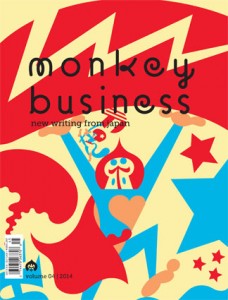
“In part, this collection is a quest. And it is a quest into questions, many of which straddle the thin lines of life, all the while hurling us through time and space, water and air, pain and pleasure, and beginnings and ends.” (A Public Space)
By Brett Rawson (Akita-ken, 2007-09) for JQ magazine. Brett is a writer, translator, and volunteer. He currently lives in New York, where he is pursuing an MFA in creative writing at The New School and is the professional development chair for the JET Alumni Association of New York. If you have job opportunities for JET alums, an interest in presenting at JETAANY’s annual Career Forum, or want to collaborate on professional endeavors, contact him at career@jetaany.org.
Meet Volume 4 of Monkey Business International: New Writings from Japan, a collection of 23 works that will take you on a wild ride through the literary landscape of Japan. In fact, it goes beyond the boundaries of Japan—as summed up by co-founders Motoyuki Shibata and Ted Goossen in the preface, Monkey Business International is “60 percent contemporary Japan, 20 percent contemporary American and British, and 20 percent modern classic Japan,” though of course not every hybrid has a categorical home.
In part, this collection is a quest. And it is a quest into questions, many of which straddle the thin lines of life, all the while hurling us through time and space, water and air, pain and pleasure, and beginnings and ends. Take for example the short story “The Man Who Turned into a Buoy” by Masatsugu Ono. The title itself seems to whisper, loosen your grip, encouraging us to suspend our disbelief and simply enjoy as our perspective gets gently nudged out of ordinary orbit.
The tale transports us to a tiny town nestled between the shoreline and the hills, which is overrun with frolicking monkeys who descend to steal food left on graves, but have been known at times to talk with villagers, and sometimes in the voice of the deceased. This town also observes the tradition of the body as a buoy—a single man tasked with the job of nakedly floating at the edge of the inlet during the day, issuing warnings to people who exit the bay. The man who turned into the buoy is the narrator’s grandfather, and his story is recounted through the grandmother in a dense dialect that is beautifully captured by translator Michael Emmerich.
JQ Magazine: Book Review – ‘Cool Japan: A Guide to Tokyo, Kyoto, Tohoku and Japanese Culture Past and Present’
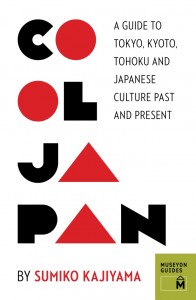
“Cool Japan focuses on giving an inside look into the enduring and captivating qualities of Japan’s culture and history and how it can be discovered by visiting Kyoto, Tokyo, and the Tohoku region.” (Museyon Guides)
By Julio Perez Jr. (Kyoto-shi, 2011-13) for JQ magazine. A bibliophile, writer, translator, and graduate from Columbia University, Julio is currently working at Ishikawa Prefecture’s New York office while seeking opportunities with publications in New York. Follow his enthusiasm for Japan, literature, and board gaming on his blog http://brittlejules.wordpress.com and Twitter @brittlejules.
When was the last time you picked up a non-fiction book and felt like you were escaping to a faraway land? Cool Japan (Museyon Guides) is the special kind of guidebook that does just that.
The author, Sumiko Kajiyama, is a journalist and scriptwriter residing in Japan. Her other books include Ghibli Magic, The Man who Changed Animation Business, The Way of Work by Top Producers, and Important Things to Enjoy Your Work and Life.
In any bookstore you will find Frommer’s, Lonely Planet, and Fodor’s travel guidebooks. You may own a few already from trips you have taken in the past. While these guides are meticulously researched and written to suit a traveler’s needs, there is an inherent problem that they all have in common: over a relatively short amount of time, prices for services or goods can change, hostels can move or go out of business, and new ones can pop up in yet undiscovered places. For these reasons, and many that need not be mentioned, the Internet has become an invaluable tool for anyone planning a trip. Many digital communities of travelers have evolved for the exchange of current information. Furthermore, smartphones allow today’s travelers to access all of this information on the go.
So you may be wondering, why buy a guidebook at all? There are many reasons to buy the ones listed above, despite the weakness of having an ever-decaying reliability of information. Cool Japan is a special because it does not squander space listing information that may no longer be relevant by the time it gets into your hands, but instead Cool Japan focuses on giving an inside look into the enduring and captivating qualities of Japan’s culture and history and how it can be discovered by visiting Kyoto, Tokyo, and the Tohoku region.
JQ Magazine: Book Review — ‘Public Properties: Museums in Imperial Japan’
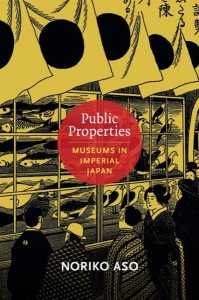
“Aso’s study is an intriguing, and refreshingly straightforward, examination of the shaping of the Japanese public in an era of increasing speed, change and modernization in the realm of how objects can promote, or even create, a national identity.” (Duke University Press)
By Jessica Sattell (Fukuoka-ken, 2007-08) for JQ magazine. Jessica is a freelance writer and a graduate student in arts journalism. Her favorite museum in all of Japan is the Fukuoka Asian Art Museum, but the Mori Art Museum is a close second.
Artist Barbara Kruger poses the pinnacle of questions in an untitled 1991 photograph and type-on-paper piece featuring a sunglasses-clad man whose mouth is twisted into a howl of wonder: “Why are you here?” She provides a few suggestions: “To kill time? To get ‘cultured’? To widen your world? To think good thoughts? To improve your social life?” When this piece is encountered within the walls of a gallery or art museum, these prompts can stir the viewer to question their place as a member of a larger conversation, rather than a simple viewer or consumer. This provokes further rumination: what do we feel when we go to museums, anywhere in the world? What connections do we have, or are we “supposed” to have, to an assortment of collected and cataloged objects arranged for public access? How are we shaped by social and political entities that can (and do) organize exhibitions around certain agendas? Design, of any kind, is never without direction.
Dr. Noriko Aso, Associate Professor of History at the University of California, Santa Cruz, addresses these, and several other powerful veins of inquiry, in her recently published book Public Properties: Museums in Imperial Japan (Duke University Press). She posits that the forerunner to the Japanese museum audience of today was shaped by governing bodies in a shift that brought state-safeguarded treasures out of storage houses and into public view. In this sense, museums in Imperial Japan (1868-1945) played a part far beyond that of the cultural repository and actually took on an active role in cultivating a Japanese national identity. Artworks, ancient artifacts and other cultural treasures helped to shape the self-representation of a self-actualized Japanese public.
Justin’s Japan: Nippon in New York — ‘Dragon Ball’ in Color, Lolita Fashions, ONE OK ROCK’s Debut

Dragon Ball Full Color makes its English-language debut in print and digital Feb. 4. (VIZ Media LLC)
By JQ magazine editor Justin Tedaldi (CIR Kobe-shi, 2001-02) for Examiner.com. Visit his Japanese culture page here for related stories.
Stay warm this winter with some hot local events, from the debut performance of one of Japan’s most successful live acts, another performance from one of the country’s biggest crossover stars, and an annual showcase that brings the sights (and tastes) of Japan to vivid life.
This month’s highlights include:
Saturday, Feb. 1, 6:00 p.m.
Asia Society, 725 Park Avenue
Free
The final entry of the film series Vengeance Is Shohei Imamura! Yasuko was exposed to black rain, the radioactive fallout from the atomic bomb dropped on Hiroshima. Years later, she and her townsmen continue to rebuild their life and endure the aftermath. At an age ripe for marriage, Yosuko has been rejected by man after man for fear of radiation, even though she has shown no signs of any illness. The film juxtaposes present-day struggles with flashbacks to scenes of wartime devastation. A departure from Imamura’s usual interest in bawdy human behavior, this film brings him closer to his early mentor Ozu, who is known for his restrained and subdued study of quiet dignity and for whom Imamura acted as assistant director.
Tuesday, Feb. 4
Dragon Ball Full Color, Volume 1
$19.99 MSRP
Akira Toriyama’s epic manga series—one of the most popular of all time—makes its English-langage debut in full color, graphic novel-size in print and digital editions! Son Goku is the greatest hero on Earth. Five years after defeating the demon king Piccolo, he’s grown up and has a family. But what is the real reason for Goku’s incredible strength? A visitor from outer space arrives bearing terrible news—Goku is an alien, and the visitor, Raditz, is Goku’s brother! When Raditz turns out to be a ruthless killer, Goku must fight his incredibly strong brother to save his family and the entire human race. A surprising alliance may be Earth’s last hope: Goku will team up with his old enemy Piccolo to save the world!
Tuesday, Feb. 4, 7:30 p.m.
Joe’s Pub, 425 Lafayette Street
$30 reserved, $35 premium
Akiko Yano returns to Joe’s Pub with her longtime New York friends/virtuoso musicians Will Lee and Chris Parker, answering overwhelming demand from the fans who caught their previous go-round in November 2012. See the pop and jazz chanteuse whom Jon Pareles of the New York Times calls “a world class songwriter with a clear, gentle, wide-ranging voice. She is also an accomplished, endearing performer who might be a Japanese Carole King, Joni Mitchell or Meredeith Monk…”
For the complete story, click here.
JQ Magazine: MIT Professor Ian Condry Explores ‘The Soul of Anime’
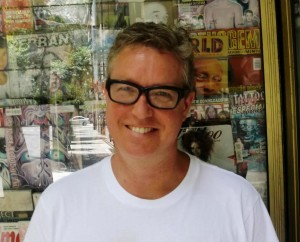
“I think it’s a challenge coming back from JET. But the times and experiences we had will really pay off in the long run even if in the short term it’s hard to see how they will apply.” (Courtesy of Web.mit.edu)
By Sheila Burt (Toyama-ken, 2010-12) for JQ magazine. Sheila is a Chicago-based journalist who blogs at www.sheilaburt.com.
Anime can easily be called a global phenomenon. In the past few decades, several anime TV series and movies have grown so successful that even people with little knowledge of Japanese culture can probably name at least one anime show or character. But how is something that is so labor intensive, costly and culturally quirky able to transcend oceans and inspire rabid fan bases?
A participant in the JETAA Regional Conference held at Harvard University earlier this month, cultural anthropologist Ian Condry (Miyagi-ken, 1988-89) explores this question in his new book, The Soul of Anime. An associate professor of comparative media studies at MIT since 2002, Condry researches cultural movements that go global, looking at how and why certain local phenomenon spread. The Soul of Anime is his second book, followed by Hip-Hop Japan: Rap and the Paths of Cultural Globalization (2006), about the inner world of Japanese hip-hop.
Although initially interested in the business model of anime, Condry changed the focus of his research after learning, rather surprisingly, that “No one gets rich making anime. And in fact, it’s a terrible business model.” Rather than looking at how anime sustains itself business-wise, Condry looks at the power of anime as a platform where, oftentimes, fans and other forms of “collaborative creativity” are at the heart of anime’s success. In order to illustrate this argument, Condry tells the story of Gundam, an anime series about giant robots that first aired in 1979. It was initially a ratings failure, but after fans created everything from encyclopedias to timelines about the show, it became a cult sensation, eventually becoming the longest-running anime series in Japanese history.
“If you look at media only in terms of the genius of the creators or the kind of business model that it fits into, then you miss the power of fans and the importance of the value they add to the products,” Condry explains. “That’s sort of what the book is about. I think now we’re starting to see that all over the place with Facebook, Wikipedia, and Twitter, all these kind of media platforms where the content is made by the users but then there’s this interaction between the users and the platform producers that make all the difference.”
JQ Magazine: Manga Review — ‘Showa 1926-1939: A History of Japan’

“If you enjoy or are interested in manga, history and yokai, or if you appreciate excellent works such as Barefoot Gen and Maus, then Showa 1926-1939: A History of Japan and the rest of the series is a must-read.” (Drawn and Quarterly)
By Julio Perez Jr. (Kyoto-shi, 2011-13) for JQ magazine. A bibliophile, writer, translator, and graduate from Columbia University, Julio is currently seeking opportunities with publications in New York. You can follow his enthusiasm for Japan, literature, and board gaming on Twitter @brittlejules.
Shigeru Mizuki is a world-famous manga artist and writer best known for his work on yokai, which deals with Japanese ghosts, monsters and supernatural stories. He is the creator of Ge Ge Ge no Kitaro, his most famous work about yokai, and he is also well known and respected in Japan for his autobiographical work about growing up and serving as as a soldier in World War II-era Japan. He created a well researched historical and autobiographical manga about the Showa period which received the Kodansha Manga Award in 1990 and is now being published in English by Drawn and Quarterly. The first of four volumes, Showa 1926-1939: A History of Japan, was translated by JET alum Zack Davisson (Nara-ken, 2001-04; Osaka-shi, 2004-06) and released last November. (For more on Davisson, read our exclusive JQ interview with him here.)
This illustrated history of Japan is praised for its accuracy in portraying the atrocities of the Japanese military during the Pacific War while also showing how the Japanese people themselves suffered on the home front. At 91 years old today, Mizuki has given us a complete and accurate account of an entire age that few alive today remember and that the rest never knew firsthand. The story is an important and valuable resource meant for generations of people who have not experienced the chaos of war and the despair of starvation. The manga is very much meant to educate the next generation of Japanese children about the controversial and darker parts of their history and to serve as a cautionary tale to remember in times of peace. It does not sugarcoat anything, and gives great insight into the tensions between Japan and China, North and South Korea, and other countries in Asia that persist today.
JQ Magazine: Book Review – ‘Life in Japan: The First Year’
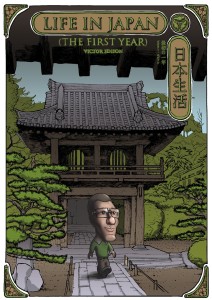
“Edison’s artistic talent captures Japan’s essence and his autobiographical account is honest and direct. JET Alumni will be able to follow his story and find many of their own experiences and thoughts represented within his work. From his first encounter ordering a hamburger to his dissatisfaction with being a glorified babysitter, his tone and pace keeps the reader hooked.” (Big Ugly Robot Publishing)
By Lana Kitcher (Yamanashi-ken, 2010-12) for JQ magazine. Lana is the business development associate for Bridges to Japan. To read more about Lana’s adventures in Japan and New York, visit her blog at Kitcher’s Café.
Victor Edison is a young man who remembers always having some Japanese influences present throughout his life. His family hosted a Japanese exchange student during his childhood, and he was fascinated by anime and manga from a young age. After graduation he found himself working a job he didn’t really want that wasn’t really going anywhere. A friend that was working in Japan at the time encouraged him to apply to be an English teacher and all he could respond to this was, “why not?”
Published by Nagoya-based Big Ugly Robot Press, Life in Japan: The First Year is a bilingual graphic novel written and drawn by Edison about his first year working for an English language school in Mie Prefecture. With little previous knowledge of the Japanese language or customs, he travels blindly to his new home armed only with his enthusiasm and determination to succeed, his ultimate goal to one day become a full-time artist.
His first choice was to work in Tokyo, simply because that was all he knew. After his interview with “Noba,” he soon learns that he has been offered a position in Mie, and accepts.
He starts work at an English conversation school located in a semi-rural area. While the majority of the clients were adults and young adults, the teachers often had to “teach” toddler classes as well. Because the school was located in a shopping mall, many parents would drop their kids off at the English school to fit in some uninterrupted shopping time. The teachers quickly learned that the child classes were thinly disguised babysitting sessions.
JQ Magazine: Book Review – ‘Dreams of Love, Etc.’ from ‘Monkey Business Volume 3’
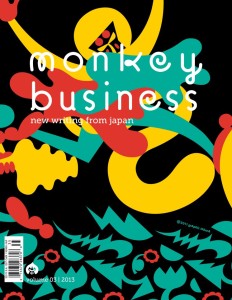
“Most striking about this piece is how astute Kawakami is in capturing not only the loneliness and boredom of daily life, but the paradox of how absurd life is and how, ultimately, it’s also really no big deal.” (A Public Space)
By Sharona Moskowitz (Fukuoka-ken, 2000-01) for JQ magazine. Sharona is interested in fresh, new voices in fiction and creative nonfiction.
In the latest issue of contemporary Japanese literature anthology Monkey Business Volume 3, Japanese novelist Mieko Kawakami writes of roses, post-earthquake malaise and a friendship that never quite consummates.
We first encounter the narrator, who inexplicably calls herself Bianca, as she stands on her porch tending to her bed of roses.
By her own admission, Bianca’s days are filled with nothing—“I don’t work. I’m not pregnant. I don’t watch TV. I don’t read books. Come to think of it, I do absolutely nothing.” What she is, however, is a wife—a loaded title for a Japanese woman with its implications of duty and decorum. Yet she wants more—much more. What exactly, she isn’t quite sure.
Stuck in the doldrums of her daily existence, she thinks and rethinks the simplest decisions, her inner monologue playing out like T.S. Eliot’s “The Love Song of J. Alfred Prufrock.” (“Shall I part my hair behind? Do I dare to eat a peach?”) What little volition she has is spent on tending to her plants, a hobby she developed after the earthquake, perhaps as an outlet for her nurturing tendencies, or, more likely, as a reminder that life was returning to normal after the shaker and its ensuing chaos.
JQ Magazine: Book Review – ‘Three Scenarios in Which Hana Sasaki Grows a Tail’

JET alum Kelly Luce’s first published collection of fiction, Three Scenarios often utilizes magic realism to tell stories that take place in Nippon. (A Strange Object)
By Rashaad Jorden (Yamagata-ken, 2008-10) for JQ magazine. A former head of the JETAA Philadelphia Sub-Chapter, Rashaad currently studies responsible tourism management at Leeds Metropolitan University. For more on his life in the UK and enthusiasm for taiko drumming, visit his blog at www.gettingpounded.wordpress.com.
As mysterious as Japan seems to be, there are numerous occurrences in the country that leave you amazed.
Enter Kelly Luce (Kawasaki/Tokushima-ken, 2002-04). The JET Program alum’s first published collection of fiction, Three Scenarios in Which Hana Sasaki Grows a Tail (which is also the title of one of Luce’s stories) often utilizes magic realism to tell stories that take place in Nippon.
Three Scenarios contains ten stories and the first one, titled “Ms. Yamada’s Toaster” (which previously appeared in the anthology Tomo), tells the tale of a toaster that can predict one’s death (the toaster even predicted the death of Ms. Yamada’s husband by popping out a piece of bread three days before he suffered a heart attack). In other stories in Three Scenarios, a teenage girl disappears during karaoke and a stone is haunted by a demon.
While there may be times in Luce’s stories that Japan may seem inconsequential, the “it could only happen in Japan” moments make her stories came alive. For example, in “The Blue Demon of Ikumi,” a foreigner woman who was considered a demon because a child died under her care is set to be executed (she eventually escapes). In “Wisher,” people make seasonal wishes at a fountain’s stone steps, such as students and parents praying before entrance exams in autumn and during summer for travel. And in the above-mentioned “Ms. Yamada’s Toaster,” some villagers wish to make the toaster a deity.
JQ Magazine – Book Review: ‘The Way of Taiko’

“Those who want to learn more about taiko, whether they are novices in Japanese drumming or have been playing for several years, will be amazed by the rich history and culture of the genre.” (Stone Bridge Press)
By Rashaad Jorden (Yamagata-ken, 2008-10) for JQ magazine. A former head of the JETAA Philadelphia Sub-Chapter, Rashaad currently studies responsible tourism management at Leeds Metropolitan University. For more on his life in the UK and enthusiasm for taiko drumming, visit his blog at www.gettingpounded.wordpress.com.
Many JETs—myself included—have been drawn to taiko because we love the sound emanating from the drums and want to partake in something traditionally Japanese. But what do we really know about taiko?
For those looking to expand their knowledge of Japanese drumming, Heidi Varian’s The Way of Taiko (now available in a new edition from Stone Bridge Press) is a great way to go. Varian, a member of the San Francisco Taiko Dojo, introduces readers to the history and contemporary culture of the music that is a symbol of Japan to many.
Varian calls taiko the “heartbeat of Japan,” and that’s appropriate because the drum was a method of gathering townspeople or letting them know about any impending danger, in addition to being used to celebrate festivals. Like seemingly everything that’s considered an integral part of Japan, taiko has an enormously long history clouded in mystery (it actually may not have originated in Japan), but Varian explores it.
She not only examines taiko’s beginning and its importance in ancient Japan, but how taiko appeared in traditional Japanese theatrical forms like noh and kabuki. She also writes about how taiko gained a foothold in the United States—the first documented taiko drum appeared in San Francisco in 1910—and its pioneers (such as Seiichi Tanaka and Kenny Endo) on this side of the Pacific. Varian also doesn’t also live in the past when talking about taiko, as she raises important issues about its future.
JQ Magazine Seeks Writers for Fall 2013!
As we head into fall, JETAA New York’s JQ magazine continues to provide content with an ever-expanding array of articles, interviews and features (see our recent stories here). We’re now looking for new writers, including recent returnees and JET vets, from all JETAA chapters worldwide for posting stories via our host at the global JET alumni resource site JETwit.com. (Scribes are also encouraged to join the JET Alumni Writers group on LinkedIn.)
Below are story ideas grouped by JET participants and alumni (JET World) and those more on Japanese culture (Japan World). And if you’re a JET or JETWit contributor from anywhere in the world with a story idea of your own, let us know!
Click “Read More” below for our fall 2013 ideas pitch package, and contact JQ editor Justin Tedaldi (magazine [at] jetaany [dot] org) to sign up for stories.
Now, JQ is looking for additional help behind the scenes! Our editor (celebrating his fifth anniversary at the helm in November) is seeking a capable assistant to help with the posting, social media sharing and story assigning across all JETAA chapters. If you’re a wiz with WordPress, Facebook and Twitter, and enjoy all forms of Japanese arts, events and media, reach out to Justin. Thanks and yoroshiku!
Percival Constantine at the Japan Writers Conference
Percival Constantine (Kagoshima 2008-2013) is a writer for GaijinPot and the Pulp Ark Award nominated author of several New Pulp novellas, including “The Myth Hunter” and “Love & Bullets.” He is also an editor at Pro Se Productions and resides in Kagoshima. At the Japan Writers Conference this year, he’s going to give a presentation titled “Self-Publishing: The Pros and Cons of Bypassing Traditional Publishing.” Here’s the official description.
 With the advent of new technology such as print-on-demand services and ebooks, the market has opened for authors who wish to go it alone and publish their books without the use of an agent or publisher. There are both positives and negatives to this approach.
With the advent of new technology such as print-on-demand services and ebooks, the market has opened for authors who wish to go it alone and publish their books without the use of an agent or publisher. There are both positives and negatives to this approach.
In the past, if one wished to publish a book, it required finding an agent and the agent locating a publisher for the product. Thanks to print-on-demand and ebook publishing, self-publishing has become easier than ever for aspiring authors. There are both positive and negative aspects to this. On the plus side, there is no need to write a number of query letters and send out submissions to agents or for the long wait before a book ends up on the market, as well as an increased share of the royalties. On the downside, the self-published author is responsible for all aspects of the production process, from editing the manuscript, laying out the book, creating a cover, and promotion. And though there is a larger share of royalties, the amount of copies sold can be far fewer. This presentation will examine the pros and cons of self-publishing.
To learn more about the Nov. 2-3 Japan Writers Conference, visit the official website HERE.
To learn more about Percival, visit his site HERE.



